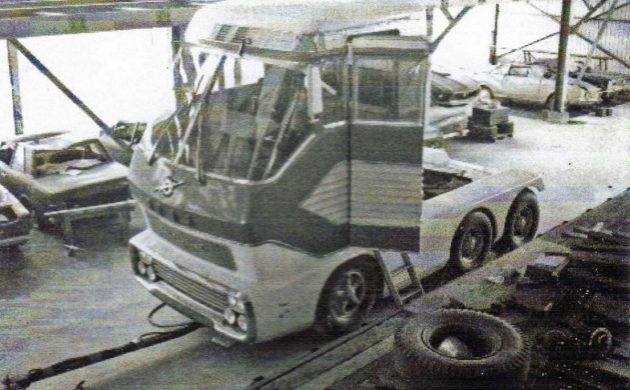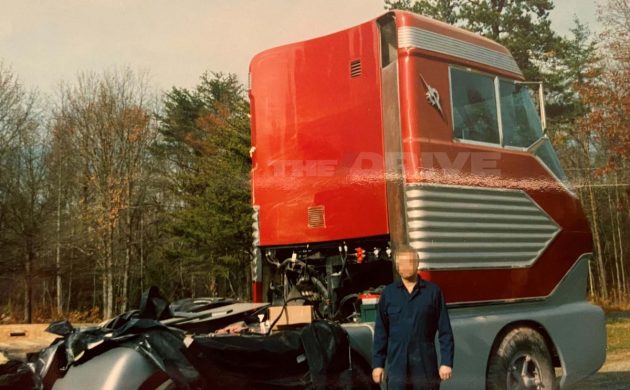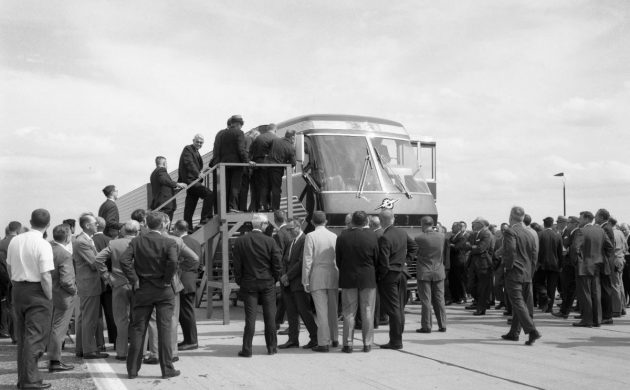It’s amazing to think of how many iconic vehicles have been lost, but also how many have been re-discovered years later. The original Bullitt Mustangs are a great example of this, especially given the actual chase car and one of the stunt vehicles were found in quick succession after years of mystery. Then there’s the infamous Chrysler Norseman, still sitting at the bottom of the Atlantic in the remains of the Andre Doria. Well, one that was missing has now been found, this time a vehicle so big, you wonder how it evaded enthusiasts for so long: it’s Big Red, the turbine-powered hauler built by Ford Motor Company. Read the full story here on The Drive, which was able to locate the concept truck after decades of hiding.
You might wonder how something this large can ever go missing. But like so many other concept vehicles, when the original manufacturer is done with it, the allure of keeping it on ice for a few generations as a way to remember what might’ve been loses its luster pretty quickly. Even with all the costs that go into its development and upkeep, it’s far easier for the big OEMs to simply wash their hands of it. In the case of Big Red, which was built to demonstrate the potential of turbine-powered vehicles, a bizarre set of incidents led to it belonging to none other than the famous race shop Holman-Moody. After being set on display at a car show in Atlanta, a driver hired by Ford to bring it back to Detroit fired up the massive turbine mill – not realizing the engine had been drained of all fluids in accordance with the rules of the convention center.
Thus began the bizarre affair wherein Big Red was being towed back to Detroit, only to have the wrecker assigned with its retrieval break down near Charlotte. Holman-Moody, having a racing contract with Ford at the time, agreed to store it until a second rescue attempt could be made. Soon after picking it up, the Clean Air Act was passed and Ford unceremoniously severed its contract with Holman-Moody, forgetting that Big Red was still in their possession. Another spat soon followed, and Ford allowed Holman-Moody to keep Big Red. A few more years passed, and Big Red went into private hands – the same hands it’s been in ever since. This picture here shows the 20,000 pound truck with its current owner, who has been painstakingly restoring it ever since.
The current owner has gone to great lengths to keep Big Red as original as possible, even purchasing a new, replacement turbine engine made by the outfit that bought the gas turbine technology from Ford. The original Allison transmission was still with Big Red when sold by Holman-Moody, but required new flexplates to mate with the replacement engine. The owner has also restored the truck to its original paint color, and fixed numerous other issues stemming from years of neglect while in the Holman-Moody shop. Today, it resides in a purpose-built structure for the massive truck, and the owner has requested that its location remain secret until he decides he’s ready to bring it back into the public eye. Kudos to The Drive for hunting down this significant piece of motoring history, and best of luck to the current owner in seeing it through to completion.






Anyone else notice all the Cortinas in the second picture?
Wonder what the story is behind that?Damaged in transit?
This is one cool truck.I hope it gets finished & displayed.
Yes I did.When they were on the ship something happened and they were damaged.HM had them at there shop and they sold parts off them.I bought a few items from them.Google Holman Moody Cortina for interesting side story.
If this is of interest, I encourage you to read the entire story; if not, Jeff has done a good job penning a summary. I read the previous story published last year where the author had gotten close to unraveling the mystery; now, the vehicle and owner are known. A great piece of investigative journalism.
I hope it will come out and be on display. But if nothing else, read the last few paragraphs in the big article. In essence, the problem is “now what do I do with it.” It’s massive and a one-off and not something one just fires up for a trip to the bank; otherwise, do you want your storage building to become a museum?
Should be donated to the Henry Ford Museum
Why is it up to the individual who owns it to donate their belonging, that they spent their time and resources restoring and maintaining? The Henry Ford museum has the means to purchase it if they so desire.
Steve R
I donate for tax reasons, not to mention, that warm gooie feeling in my heart when I do so. Todd only made a suggestion, lighten up.
Curt, you are such a good person.
Steve R
Some years ago I e-mailed the Smithsonian asking if they’d like to have my collection of CB radios from 1960 to 1979.
I’m still waiting for them to return my call…
The Ford Museum and Greenfield Village are a national treasure. They should be on everyones’ bucket list. I can think of worse places to donate to.
I visited the Ford Museum and Greenfield Village in 1966, and was fascinated. I would love to go back; maybe after I retire.
I remember seeing that truck sitting behind one of the buildings at Holman-Moody’s shop behind the airport in Charlotte NC way back in the mid seventies. There’s a few of those guys left, maybe they’ll chime in.
Hi OBG, the trailers went to H-M’s marine racing division.
Sweet looking truck. I’ve heard of Big Red. It’s too bad it was never put into production. Whatever the engine, I would think it’d make an attractive looking truck.
It’s a shame that this concept truck was never made into production. Whatever the engine powering the final product, I would’ve thought it’d make an attractive workhorse.
I just read a story about the us rig in Hemings Motor News a few days ago. The trailer went by the way side some time ago. Gas turbine engines just never quite made the grade for cars or trucks. But that sure is a sweet looking tractor.
God bless America
I graduated from high school in 1976 and in my sophomore year we had a social studies teacher who is really cool and thought out of the box. He somehow got a hold of a promotional video showing Ford’s Big Red as the future of trucking I remember sitting on the floor cross legged Indian style with my pals Marty and Charley and being mesmerized by this film showing the inside of the cab and it’s creative styling lines. WOW to see it again
Posted this in the wrong spot! Is this the video you remember seeing? https://www.youtube.com/watch?v=pv_SGS0UPUc
The Big Red portion begins at 2 minutes.
Fun to watch!
wanna C da inside of the ‘trailer” (but ‘gone’ now?).
“Peter Pan Bus Lines”, Springfield, MA has a doz or more antique busses they bring out to parade occasionally. I C only 1 here. https://www.pinterest.com/pin/52565520620253832/.
at top and dwn the page, side view, left of the 2 middle columns. Today we need streamline, energy savings (and the Walmart Volvo is an example) designs. These from the ’20s, 30s’n 40s could be the thing !
I remember when Ford was touring with this. I was pretty young at the time. I can’t remember who started testing Turbine power on the road first. Chrysler comes to mind as they were playing with turbines in the 50s. I remember the Turbine car and it wasn’t long before GM came out with the Turbo-Titan III. I was told that Ford was testing Big Red about the same time. Sure would’ve loved to see them in the flesh…
Hi Geo, it was Kenworth that dabbled in turbines in the 50’s. I believe CF had a few turbine cabover Freightliners made for CF too. It’s funny, aerodynamics were thought of in the 60’s, but not put into use for 40 years. While turbines showed some promise, they didn’t pan pout for the same reasons turbine cars failed. They ran hot, had serious throttle lag, and got dismal fuel mileage, half that of a diesel.
https://www.pinterest.com/pin/119204721366137928/
Hello Howard. So KW and Freightliner got into the turbine gig too. Well the opportunity was there so why not? Back then companies could experiment with no interference or hype from government or special interest groups. Sure isn’t the case these days…
Here’s CF’s rig. Look at those stacks, needed to dissipate the heat. Today, those big 8″ stacks are all the rage,,
https://www.pinterest.com/pin/634163191250665435/
Big red allegedly would get 2.1MPG
Trucking industry magazine Fleet Owner did a full-blown road test of the Chrysler turbine tractor in the mid 60’s. It was by an editor named Jack Lyndal, famous for describing every nut and bolt in his stories as well as for his collection of Studebakers, which he drove to all assignments. Unfortunately it only exists in print and I have no idea who still has the archives.
BIG RED! I forgot about that truck. I saw it in person at the 1964 Worlds Fair (Boy do I feel old!) we were at the Ford Rotunda. (I was car crazy then; I think I was born that way.) Ok, in those days I was 8 years old, but it seemed immense! It was like building! All the features inside, a turbine, wow! That and the Chrysler Turbine car were the whole fair to me! (and the Uniroyal Ferris wheel…and the GE Carousel of progress…and Belgin Waffles!)
Is this the video you remember seeing? https://www.youtube.com/watch?v=pv_SGS0UPUc
What should be done is a turbine electric hybrid for semis. The turbine could run a constant rpm at max efficiency to power batteries that then drive the wheels, sort of like locomotives but I know they run big diesels. Would seem to be the best of both worlds.
A turbine has its advantages but from what I see, ALL of those advantages are 20K+ feet in the air. Out in the prairies, I’ve seen a lot of sprayer planes in operation. Not all that long ago those Grumman Ag Cats ran Pratt and Whitney Wasp engines. Pilots praised them because of their torque and their ability to get moving when they firewalled the throttle. The Ag Cats got “updated” to PT-6 Turbine engines which put out close to 300 hp more than the old ‘Corncobs.’ Pilots didn’t like them at all. The new ones coming up are fine with them but then, they didn’t know the performance of the radials.
Another theater of operations is in Bush Country. For years some of the most popular bush planes was the ‘Otter’ and the ‘Beaver.’ Both powered by radials and both had an excellent service record. Now, bush pilots don’t do a ‘weight and balance;’ they only do a balance. If the tops of the floats are level with the water surface they’re considered balanced, and ready to fly. If they cannot get it off the water, only THEN, is it considered overloaded. Well, firewall those ol’ Corncobs, and the floats were up on top. Some speed and full flaps and they were off the water. All was well until someone decided to ‘update’ them by pulling off the corncobs and attaching a PT-6 (P-120 on the single Otter). Even with 50% more power, pilots were finding out to their dismay that they couldn’t get the damned things off the water; those engines just wouldn’t spool up. Then, when they did get them flying, those turbines drank 50% more fuel. Now I’m only going by what the pilots told me but I was flown out on service calls to many camps and I not only talked to a lot of pilots but I remember watching how fast those trees on the opposite end of the lake were growing. I was quite relieved to see them pass by underneath.
Turbines have their place, and I think that the companies that experimented with them on the roads took them as far as they could before they realized that there were limits. I do think that the concept of diesel-electric is a good idea. It’s worked great in locomotives and I’ve seen a lot of rock trucks with that. Of course there are some who doggedly think that straight electric propulsion is the way to go…